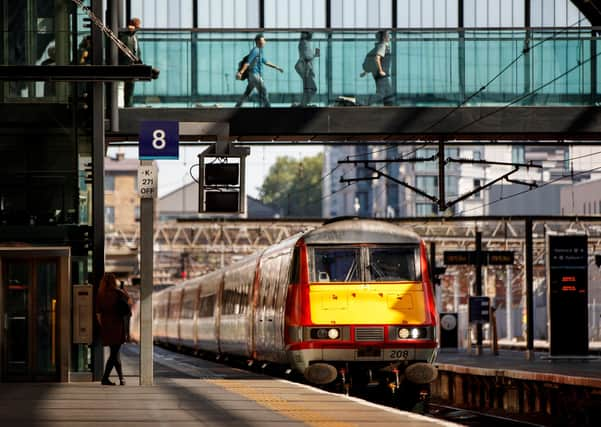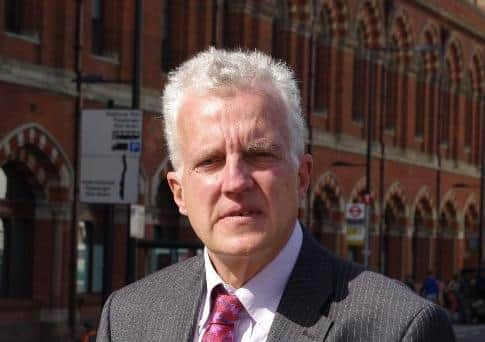How to get rail services back on track to avoid Beeching-like cuts – Christian Wolmar


But will anyone care? It is, of course, fortunate that this is taking place at a time when railway passenger numbers are at roughly 14 per cent of normal as it means very few will experience disruption to their journey.
But the rather bigger question than concern over a few adversely affected journeys is how many of these lost passengers will ever return.
Advertisement
Hide AdAdvertisement
Hide AdAnd, indeed, what should be done about the railways if many of them don’t?


In researching my latest book, on the history of London’s dozen terminus stations, I spent a day visiting them all in the middle of the first lockdown. It was a disheartening experience.
King’s Cross at 9am had more pigeons than people on the concourse, and the same was true of all the others. The handful of travellers, most of whom were wearing masks, looked uncomfortable and anxious, leaving the stations as hastily as possible.
There was very strong messaging from the Government and the rail companies that travelling by rail was risky and should be undertaken only if totally necessary.
In any case, there was no reason to linger.
Advertisement
Hide AdAdvertisement
Hide Ad

Most of the food outlets and all the shops were shut. There was none of the hurly-burly that made these stations such an important part of the London I love and where I have lived my whole life. I want it back, but I suspect that it will never be the same again.
Certainly there are some aspects that won’t be missed. Those crowded morning trains with people straphanging and wedged in by the sheer weight of numbers were not a great way to get to work.
The whole commuter operation was a service stretched to the limit – not just in London, as rush-hour trains into Leeds, Manchester and Birmingham were equally rammed and, as a result, often late, thanks to the time taken to get people on and off.
Indeed, once offices are open again, those travelling to and from them will enjoy being able to sit down and stretch their legs, even if the timetable is cut back and there are fewer services.
Advertisement
Hide AdAdvertisement
Hide Ad

While that may seem a cause to rejoice, the prospect of half-empty trains is not economically sustainable in the long term.
Currently, the railways receive roughly £800m of taxpayers’ money to tide them over the pandemic. That is in addition to the £4-£5bn spent annually on investment and to the billions being spent on HS2, a project that now looks like becoming a white elephant before it is even completed.
The railways have enjoyed a couple of decades of sustained growth which saw passenger numbers double from 2000 and there has been considerable investment to accommodate this growth, such as the work being undertaken at King’s Cross.
Now, though, the railways will struggle to get up to 50 per cent of pre-pandemic usage, let along the 80-90 per cent that railway managers and ministers are hoping for.
Advertisement
Hide AdAdvertisement
Hide AdFew people who have been able to work successfully at home will relish the prospect of a five-day weekly commute. Both anecdotal and survey evidence suggests a permanent shift away from daily commuting, with people going in a couple of days a week at most.
Moreover, many business trips will now be replaced by Zoom or Teams calls. We have all got thoroughly used to using these new methods of communication.
Worse, the strong messaging about the risks from Covid-19 faced by rail passengers has left a permanent mark, with many remaining concerned, even though subsequent research has shown that the risk is slight and probably less than going to the supermarket.
As a result of the collapse in passenger numbers, the railways have absorbed more extra spending due to the pandemic than any other category of government activity apart from the NHS. That cannot be permanent.
Advertisement
Hide AdAdvertisement
Hide AdSo far, transport ministers have been able to stave off Treasury demands to cut back services and close down lines. They have pointed out that any mothballing of routes could well end up being permanent because of the way that unused railways and rolling stock quickly deteriorate.
But the Treasury cannot be kept at bay forever.
It will not be long before there will be a round of cuts that will make Beeching’s axe look blunt, unless there is a rapid return to train travel of a substantial proportion of its past users. To achieve this, the railways need to provide an attractive service, with free wi-fi, modern trains and, crucially, affordable fares.
Yet, the Government has said it is pushing ahead with above-inflation fare rises of 2.6 per cent next month.
This goes against the most basic rule of economics that prices should move up or down in line with demand.
Advertisement
Hide AdAdvertisement
Hide AdBut somehow ministers have failed to learn this fundamental lesson.
There is more than the fate of the railways at stake.
Town centres will wither and die without the daily influx of commuters that stimulate a raft of businesses from food shops and pubs to hairdressers and heel bars.
The Government should not only reverse the fares rises, but implement a simpler fares system to attract people back.
After all, what is the point of peak fares such as the £136.50 flexible one-way fare from Leeds to London when there is no longer a peak?
Advertisement
Hide AdAdvertisement
Hide AdChristian Wolmar is a journalist, author and rail historian. To obtain a signed copy of his book, Cathedrals of Steam – How London’s Great Stations Were Built, go to www.christianwolmar.co.uk
Support The Yorkshire Post and become a subscriber today. Your subscription will help us to continue to bring quality news to the people of Yorkshire. In return, you’ll see fewer ads on site, get free access to our app and receive exclusive members-only offers. Click here to subscribe.
Comment Guidelines
National World encourages reader discussion on our stories. User feedback, insights and back-and-forth exchanges add a rich layer of context to reporting. Please review our Community Guidelines before commenting.